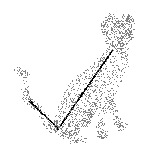Spotlight on a Frequently Asked Question
SHOULD WE USE CATS AS MOUSERS?
The short answer is no. For a detailed response, see below.
Why not? Aren't cats supposed to kill mice and rats?
Cats do kill mice and rats, but they also kill many non-target species. The domestic cat is a prolific hunter of birds, small mammals, reptiles and amphibians. Cats do not distinguish among the species they kill. More than likely, when a cat is employed to keep pests at bay, she is also harming native wildlife. Cats can kill rare, threatened or endangered species or species of special concern, as well as many common species. Barn swallows, Carolina wrens and other magnificent wild creatures that share our spaces needlessly die due to this knee-jerk response to rodent problems.
In fact, results of a study published in 2004 by Hawkins, et al. stated: The presence of homeless house cats that received supplemental food had a negative impact on native California rodents and birds. Native rodents and birds were less abundant and the exotic house mouse was found to be more abundant in areas where cats were being fed.
But isn't this a natural way of handling rodent problems?
No. Cats are not a natural part of the ecosystem. They are a non-native, invasive predator species. Employing a non-native, invasive predator to control a problem species can have unintended serious consequences. A good example of this is the introduction of the mongoose to the islands of Hawaii. Instead of controlling non-native rats, the mongoose preys upon native nene birds and eats nene eggs and young. This endemic Hawaiian goose faced extinction due to relentless predation by the mongoose and other non-native mammals, as well as habitat destruction and hunting. Fortunately, a long-running captive breeding effort and predator control have reversed this near tragedy.
Isn't using cats to kill mice and rats environmentally friendly?
Not at all! There is nothing environmentally friendly or 'green' about unleashing a non-native, invasive predator that destroys so much more than what is intended. The collateral damage does not justify the use of cats as mousers. Cats do not add to biodiversity - they deplete it.
Furthermore, cats are the only species to shed the parasite toxoplasma gondii in their feces. According to the CDC, this parasite can live in the environment for many months and contaminate soil, water, fruits and vegetables, sandboxes, grass where animals graze for food or any place where an infected cat may have defecated.
Toxoplasmosis is an infection caused by this parasite. More than 60 million people in the U.S. carry the Toxoplasma parasite. Toxoplasmosis can cause severe illness in infants infected before birth (when their mothers are newly infected during pregnancy), or in persons who have a weakened immune system.
Cats get Toxoplasma infection by eating infected rodents, birds or other small animals, or anything contaminated by feces from another cat that is releasing the parasite.
For more information about how this parasite actually attracts rats to cats, listen to a fascinating audio report on NPR Sneaky Parasite Attracts Rats to Cats.
Don't mice and rats carry diseases?
Of course, and there may be a need for removal of these non-native rodent species, but utilizing cats is not a good choice for control.
Are you saying we should use pesticides instead?
No. Pesticides, like domestic cats, are a serious secondary cause of wildlife mortality.
Then what should we do?
As Benjamin Franklin stated: An ounce of prevention is worth a pound of cure. Make the area inhospitable for mice and rats. For tips on prevention and other information see Minimizing Mouse Madness: a guide to house mouse control, a publication by Beyond Pesticides.
Control mice and rats naturally by encouraging the presence of great-horned owls and barn owls. Erect a fifteen-foot platform on which birds of prey can perch. Do not cut down dead trees (as long as they do not pose a danger if they should fall) as these also serve as good perching spots for raptors. Snakes are excellent for rodent control, too. Native predators are not in abundance and therefore do not deplete the food supply or wreak havoc on wildlife populations. Their effect on wildlife has an ecological basis unlike that of domestic cats, whose out-of-control population is vastly larger than all native predators put together.
Are there any other reasons why we should not use cats as mousers?
Yes. Outdoor cats are exposed to many dangers. They are hit by cars, poisoned, attacked by dogs and coyotes and abused by humans. They are vulnerable to internal parasites such as roundworm and hookworm and external parasites such as fleas and ticks and may be exposed to fatal feline diseases. Domestic companion animals permitted to roam freely are not safe.
Finally, if we are to encourage responsible pet ownership by asking folks to keep their cats indoors for the protection of felines and the preservation of wildlife we undermine that commitment and that message by saying that some cats can and should be working cats or barn cats or mousers. Cats are not wildlife and their home is not outdoors.
